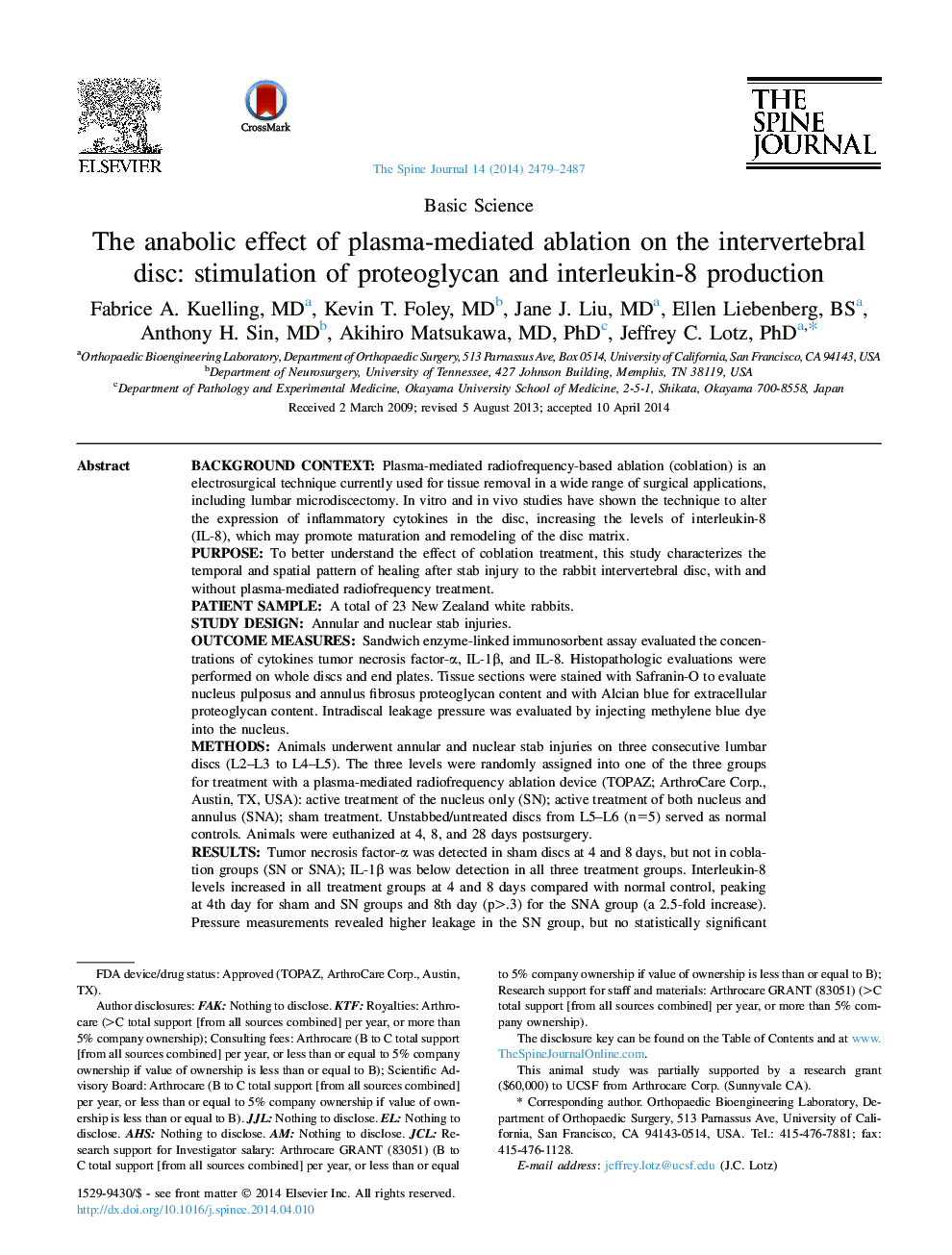| کد مقاله | کد نشریه | سال انتشار | مقاله انگلیسی | نسخه تمام متن |
|---|---|---|---|---|
| 4096765 | 1268570 | 2014 | 9 صفحه PDF | دانلود رایگان |
Background contextPlasma-mediated radiofrequency-based ablation (coblation) is an electrosurgical technique currently used for tissue removal in a wide range of surgical applications, including lumbar microdiscectomy. In vitro and in vivo studies have shown the technique to alter the expression of inflammatory cytokines in the disc, increasing the levels of interleukin-8 (IL-8), which may promote maturation and remodeling of the disc matrix.PurposeTo better understand the effect of coblation treatment, this study characterizes the temporal and spatial pattern of healing after stab injury to the rabbit intervertebral disc, with and without plasma-mediated radiofrequency treatment.Patient sampleA total of 23 New Zealand white rabbits.Study designAnnular and nuclear stab injuries.Outcome measuresSandwich enzyme-linked immunosorbent assay evaluated the concentrations of cytokines tumor necrosis factor-α, IL-1β, and IL-8. Histopathologic evaluations were performed on whole discs and end plates. Tissue sections were stained with Safranin-O to evaluate nucleus pulposus and annulus fibrosus proteoglycan content and with Alcian blue for extracellular proteoglycan content. Intradiscal leakage pressure was evaluated by injecting methylene blue dye into the nucleus.MethodsAnimals underwent annular and nuclear stab injuries on three consecutive lumbar discs (L2–L3 to L4–L5). The three levels were randomly assigned into one of the three groups for treatment with a plasma-mediated radiofrequency ablation device (TOPAZ; ArthroCare Corp., Austin, TX, USA): active treatment of the nucleus only (SN); active treatment of both nucleus and annulus (SNA); sham treatment. Unstabbed/untreated discs from L5–L6 (n=5) served as normal controls. Animals were euthanized at 4, 8, and 28 days postsurgery.ResultsTumor necrosis factor-α was detected in sham discs at 4 and 8 days, but not in coblation groups (SN or SNA); IL-1β was below detection in all three treatment groups. Interleukin-8 levels increased in all treatment groups at 4 and 8 days compared with normal control, peaking at 4th day for sham and SN groups and 8th day (p>.3) for the SNA group (a 2.5-fold increase). Pressure measurements revealed higher leakage in the SN group, but no statistically significant differences. Histopathology showed higher proteoglycan production by 28 days in the SNA and SN groups compared with sham. All three treatment groups showed ruptured annular fibers from the stab injury, but maintained the overall architecture. Remnants of notochordal tissue within the nucleus were evident in all treatment groups at 4 and 8 days, but were only found in sham group by 28 days. At this time, unlike the normal or sham controls, the nucleus of SN and SNA discs had fibrocartilaginous tissue with chondrocyte-like cells. Significant differences in the disc architecture grade were only noted when comparing normal controls with other groups by 28 days (p<.001).ConclusionsPlasma-mediated radiofrequency ablation appears to have an anabolic effect on disc cells, stimulating proteoglycan and IL-8 production and maintaining annulus architecture. Coblation treatment appears to reduce cellular response to proinflammatory stimuli and restore overall disc architecture that may prove beneficial in a number of degenerative disc paradigms. Further studies are encouraged to investigate the therapeutic effect of the technique.
Journal: The Spine Journal - Volume 14, Issue 10, 1 October 2014, Pages 2479–2487
